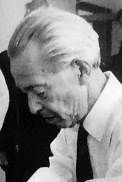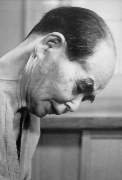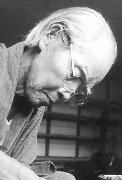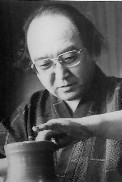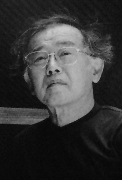--Bizen ware type of pottery--
We welcome all visitors to Kawaguchi Pottery Gallery Website and wish you a happy shopping. Kawaguchi Pottery Gallery is dealing with a wide selection of Bizen ware works by Human National Treasure and contemporary artists.
<About Bizen ware>
Bizen ware is a type of Japanese pottery most identifiable by its ironlike hardness, reddish brown color, absence of glaze, and markings resulting from wood-burning kiln firing.
Bizen is named after the village in Okayama prefecture, 2 hours from Osaka by train. This artwork is Japan's oldest pottery making technique, introduced in the Heian period, about one thousand years ago. Bizen is one of the six remaining kilns of medieval Japan.
Bizen clay bodies have a high iron content and, traditionally, much organic matter that is unreceptive to glazing. The clay can take many forms.
The surface treatments of Bizen wares are entirely dependent on yohen, or "kiln effects." Pine ash produces goma, or "sesame seed"
glaze spotting. Rice straw wrapped around pieces creates red and brown scorch marks. The placement of pieces in a kiln causes them to be fired under different conditions, with a variety of different results.Considering that one clay body and type of firing is used, the variety of results is remarkable.
Bizen wares are fired slowly over a long period of time. Firings take place only once or twice a year. They require the wood fire to be kept burning for 10-14 days involving long hours and tons of wood.
<Notes on the online shopping>
We are dealing Bizen ware at both the galley in Bizen and this website. Please note that the items which you find on the website sometimes have already been sold at the galley. The pictures you see on the website may look slightly different from the actual items depend on the configuration of your computer.
We use “PayPal” for your payment. Please have your PayPal account before you start your purchase process.
Then, please put your desired items in your shopping basket, and input your information. After that, total amount including shipping cost will be shown on the PayPal website. You can complete your purchase after finishing your payment and finding the order confirmation on the screen.
You may need to pay customs, VAT and any other tax in you your country when you receive the parcel. We don’t have any responsibility for that.
If you have any further questions, please contact us through our Contact form. We hope you enjoy the world of Bizen ware and shopping.
Products Categories
The Living National Tresure(人間国宝,Ningen kokuho)of Bizen Ware
Toyo Kaneshige(1986-1967, born in Inbe Bizen-city) was born as first-born son of Biyo Kaneshige. Kaneshige is one of the six oldest family lines of the Bizen kilns. Toyo studied under his father and became popular as a craftsman of Japanese tea pot. From 1910-1940, he begun to make potteries used in Japanese tea ceremony, and was successful in attempts to make wares of Momoyama period quality.
Momoyama (1568-1600), was the golden age of art in Japan, and of Bizen ware. Many Bizen wares were used in tea ceremony. He has a wide range of friend ship with Japanese artists such as Hndeishi Kawakita, Toyozo Arakawa, Kyusetu Miwa, and after WWⅡ, he was influenced by Rosanjin KItaoji and Isamu Noguchi, and expanded the range of his art works. He was made the first Human National Treasure from Bizen ware artists. He was invited to Hawaii University as a summer time lecturer in 1964 and 1966.
Kei Fujiwara(1899-1983, born in Bizen city) became Bizen ware artist with encouragement from Japanese literature scholar, Atuo Masamune. He studied handling of the potter's wheel from Baikei Mimura, and from 1941, studied burning method from Toyo Kaneshige. His made crocks and flower vases with generosity and lucidness after the fashion of commodity at Kamakura and Muromachi Era(1192-1573). His works shows cultivation absorbed at his early days. In 1954, he was made Human National Treasure secondly from Bizen ware artists. He became commissioner of Japan Art Crafts Association in 1958, and established Kei Fujiwara memorial hall in 1977 in Bizen city, Okayama Prefecture. Toshu Yamamoto(1906-1994, born in Inbe Bizen-city) started his career as Bizen ware artist in 1922, and created his own kiln in 1933. After that, he studied from Yaichi Kusube, pottery artist in Kyoto. After WWⅡ, he has a friendship with Rosanjin Kitaoji and Isamu Noguchi. He made sensitive works with excellent potter's wheel techniques and was called "Master of potter's wheel". He prefers to make tea containers.
He was made Human National Treasure. He hold the exhibition "Journey to six old kiln, Human National Treasure, Toshu Yamamoto" in 1992.
Yu Fujiwara(1932-2001, born in Bizen-city Okayama Prefecture) is first son of Kei Fujiwara, Human National Treasure. With the motto "Simple, Perspicuity, Masculine", he made a lot of crocks and bowls and was called "Yu of Crocks". He also was good at making plate wares affected by Rosanjin KItaoji. From 1972, he hold various exhibitions and made many large scale of wall reliefs and artworks. In 1980, he was made important intangible cultural heritage of Okayama prefecture. In 1996, he was made Human National Treasure. Jun Isezaki was born as second son of Yozan Isezaki, famous for excellent workmanship. He learned Bizen ware from his childhood and became Bizen ware artist after graduating art department of Okayama University in 1959. He makes wide variety of artworks such as, flower vase, dish, tea ware and wall relief from traditional to artistic ones. Contemporary is one of his characteristics exploiting flavor of clay bodies and kiln, (kiln made by digging a hole, ascending, and electric one). He showed many artworks as relief artist. He worked as lecturer at art department of Okayama university from 1978-1987. In 1988, he was made important intangible cultural heritage of Okayama prefecture with his elder brother, Mituru Isezaki, and then in 2004, was made Human National Treasure.







